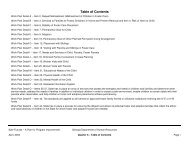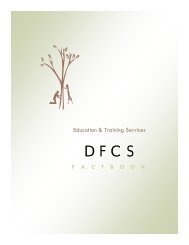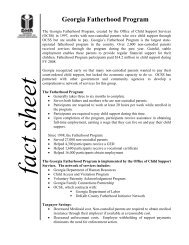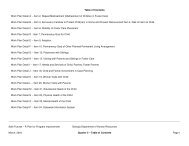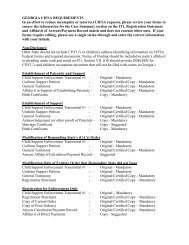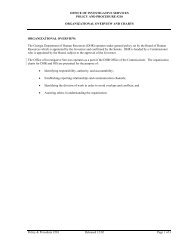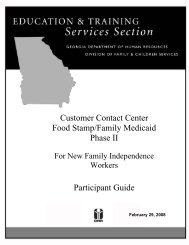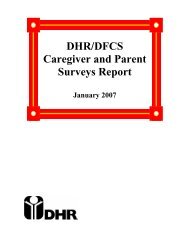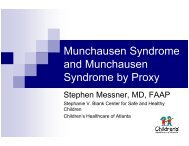an overview georgia program improvement plan - Department of ...
an overview georgia program improvement plan - Department of ...
an overview georgia program improvement plan - Department of ...
You also want an ePaper? Increase the reach of your titles
YUMPU automatically turns print PDFs into web optimized ePapers that Google loves.
Georgia:<br />
Georgia’s Program Improvement Pl<strong>an</strong>, Safety # 1, Item 2, addressed reducing the incidence <strong>of</strong> child abuse, neglect, or both <strong>of</strong> children in foster care from Georgia’s 1999<br />
incidence <strong>of</strong> maltreatment in foster care rate <strong>of</strong> 1.08% to less th<strong>an</strong> or equal to 0.94%. While reporting data indicates that Georgia has fallen short <strong>of</strong> achieving the National<br />
St<strong>an</strong>dard <strong>of</strong> maltreatment (.057%) in foster care, Georgia has achieved Georgia’s goal <strong>of</strong> 0.94% or less during FFY 2002 <strong>an</strong>d in the first two reporting quarters in FFY 2004.<br />
Georgia attained 0.79% in FFY 2002, <strong>an</strong>d in FFY 2004 Georgia achieved 0.80% in the first quarter <strong>an</strong>d 0.94% in the second quarter. Conversely, the QCR rated this indicator as a<br />
strength in 94 <strong>of</strong> the 102 applicable cases reviewed (92.16%). Eight <strong>of</strong> the 33 subst<strong>an</strong>tiated referrals identified involved the same alleged perpetrator <strong>an</strong>d six involved the same<br />
general complaint. To reduce the maltreatment <strong>of</strong> children in foster care Georgia has achieved the following outcomes:<br />
• Georgia’s data collection system has been enh<strong>an</strong>ced to allow for:<br />
Tracking <strong>of</strong> maltreatment in private agency foster homes <strong>an</strong>d <strong>of</strong> non-child welfare children abused in institutional settings,<br />
Descriptive statistics <strong>of</strong> foster care victims which permit the comparison <strong>of</strong> foster care victims to non-victim foster children,<br />
The proportion <strong>of</strong> reports by placement setting, <strong>an</strong>d<br />
A pr<strong>of</strong>ile <strong>of</strong> foster families involved in maltreatment investigations.<br />
These data enh<strong>an</strong>cements have been used for social services policy development <strong>an</strong>d as <strong>an</strong> indicator for social service staff training. We c<strong>an</strong> now sort data by provider groups. We<br />
c<strong>an</strong> target training wherever it is needed to DFCS foster parents, private agency foster parents, or for employees at a childcare institution.<br />
• Policy <strong>an</strong>d training for Georgia’s social services staff, foster parents, <strong>an</strong>d institutional staff have been critiqued, new policy <strong>an</strong>d curriculum has been developed, <strong>an</strong>d<br />
training begun.<br />
The Education <strong>an</strong>d Research Section has developed new curriculum for social services staff training.<br />
A new curriculum has been developed for social services staff <strong>an</strong>d foster <strong>an</strong>d institutional staff titled IMPACT. Training on IMPACT Leader Certification is<br />
concluded. Training <strong>of</strong> Georgia’s Social Service staff on Leader Certification was completed in October 2004. Training <strong>of</strong> private agency staff beg<strong>an</strong><br />
immediately thereafter. Private agency staff c<strong>an</strong> select training from <strong>an</strong>y <strong>of</strong> the nationally recognized trainings or may choose Georgia's IMPACT.<br />
The quarterly rates <strong>of</strong> incidence <strong>of</strong> child abuse in foster care warr<strong>an</strong>t serious further study by the state; Georgia is committed to such a follow-up <strong>an</strong>d to reducing the maltreatment<br />
<strong>of</strong> children in foster care.<br />
Safety 2, Children are Safely maintained in Their Homes Whenever Possible:<br />
Safe Futures – A Pl<strong>an</strong> for Program Improvement<br />
Georgia <strong>Department</strong> <strong>of</strong> Hum<strong>an</strong> Resources<br />
November, 2004 Quarter 8 – Table <strong>of</strong> Contents Page iii




